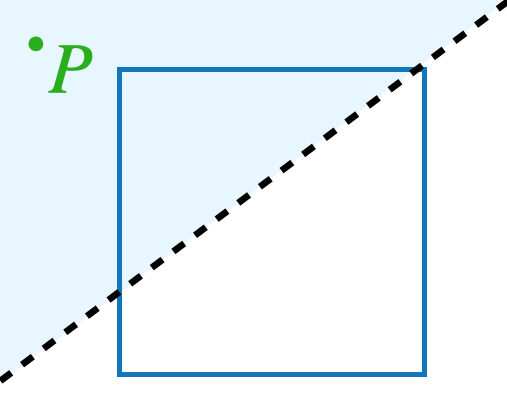Problems
During the ball every young man danced the waltz with a girl, who was either more beautiful than the one he danced with during the previous dance, or more intelligent, but most of the men (at least 80%) – with a girl who was at the same time more beautiful and more intelligent. Could this happen? (There was an equal number of boys and girls at the ball.)
A \(1 \times 10\) strip is divided into unit squares. The numbers \(1, 2, \dots , 10\) are written into squares. First, the number 1 is written in one square, then the number 2 is written into one of the neighboring squares, then the number 3 is written into one of the neighboring squares of those already occupied, and so on (the choice of the first square is made arbitrarily and the choice of the neighbor at each step). In how many ways can this be done?
Imagine an infinitely large sheet of paper with a square drawn on it. Somewhere on the paper, a point \(P\) is marked with ink that is invisible to you. However, a friend with a special pair of glasses can see the point.
We are allowed to draw straight lines on the paper, and for each line, our friend will tell us on which side of the line the point \(P\) is. (If \(P\) is exactly on the line, they will say so.) For example, on this picture, our friend would say that the point \(P\) is above the line we’ve drawn:

What is the smallest number of such questions that are needed in order to be certain whether \(P\) lies inside the square? Explain why it cannot be done in less questions then you are suggesting.
Initially, on each cell of a \(1 \times n\) board a checker is placed. The first move allows you to move any checker onto an adjacent cell (one of the two, if the checker is not on the edge), so that a column of two pieces is formed. Then one can move each column in any direction by as many cells as there are checkers in it (within the board); if the column is on a non-empty cell, it is placed on a column standing there and unites with it. Prove that in \(n - 1\) moves you can collect all of the checkers on one square.
A cube with side length of 20 is divided into 8000 unit cubes, and on each cube a number is written. It is known that in each column of 20 cubes parallel to the edge of the cube, the sum of the numbers is equal to 1 (the columns in all three directions are considered). On some cubes a number 10 is written. Through this cube there are three layers of \(1 \times 20 \times 20\) cubes, parallel to the faces of the cube. Find the sum of all the numbers outside of these layers.
Two people are playing. The first player writes out numbers from left to right, randomly alternating between 0 and 1, until there are 2021 numbers in total. Each time after the first one writes out the next digit, the second switches two numbers from the already written row (when only one digit is written, the second misses its move). Is the second player always able to ensure that, after his last move, the arrangement of the numbers is symmetrical relative to the middle number?
In Conrad’s collection there are four royal gold five-pound coins. Conrad was told that some two of them were fake. Conrad wants to check (prove or disprove) that among the coins there are exactly two fake ones. Will he be able to do this with the help of two weighings on weighing scales without weights? (Counterfeit coins are the same in weight, real ones are also the same in weight, but false ones are lighter than real ones.)
Janine and Zahara each thought of a natural number and said them to Alex. Alex wrote the sum of the thought of numbers onto one sheet of paper, and on the other – their product, after which one of the sheets was hidden, and the other (on it was written the number of 2002) was shown to Janine and Zahara. Seeing this number, Janine said that she did not know what number Zahara had thought of. Hearing this, Zahara said that she did not know what number Janine had thought of. What was the number which Zahara had thought of?
On a table there are 2022 cards with the numbers 1, 2, 3, ..., 2022. Two players take one card in turn. After all the cards are taken, the winner is the one who has a greater last digit of the sum of the numbers on the cards taken. Find out which of the players can always win regardless of the opponent’s strategy, and also explain how he should go about playing.
In a basket, there are 30 mushrooms. Among any 12 of them there is at least one brown one, and among any 20 mushrooms, there is at least one chanterelle. How many brown mushrooms and how many chanterelles are there in the basket?